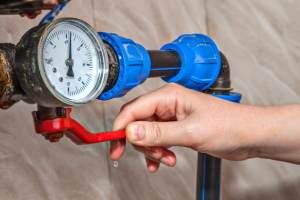 The first five minutes of a plumbing emergency are critical. If you are prepared and know what to do, you can keep the mess from spreading and protect your home until a plumber arrives.
The first five minutes of a plumbing emergency are critical. If you are prepared and know what to do, you can keep the mess from spreading and protect your home until a plumber arrives.
Below, this emergency plumber in Glencoe, Illinois is going to share some tips on what you should do during those first few moments.
The single most important step is to stop the flow of water immediately. Every extra minute that water is running into your home increases the amount of damage to your floors, walls, and furniture.
Find the closest shut-off valve and turn it clockwise. That will stop the flow at that point.
For sinks and toilets, you will find a valve nearby. If the leak looks bigger or you cannot easily see where the water is coming from, go directly to the main shut-off valve. Most homes have it in the basement, near an outside wall, or close to the main utility area.
Shutting off the main valve will buy you time and keep the situation from getting worse while you wait for an emergency plumber in Glencoe, Illinois to arrive.
Even with the main supply turned off, water remains in the pipes and will likely still be under pressure. That pressure can push water out through the broken spot if you do not release it.
Open a faucet at the lowest level of your home, like a basement sink, to let it drain until the flow slows down. This will drain most of what is left.
If the leak involves your water heater, turn it off immediately. For gas models, set the thermostat dial to the “off” position. For electric models, you need to go to the breaker panel and flip the switch off, so no power reaches the water heater.
Do not try draining the tank on your own unless a plumber has already told you it is safe. You should also never try to relight burners yourself if they go out. If you hear hissing or sizzling, step back and wait for a licensed technician to inspect it.
Heavy storms and flooding can overwhelm sump pumps. And if the power goes out, they can stop working completely, which is when water starts building up in your basement.
If you see that your pump is not turning on, check the outlet first to see if it still has power. Then check the breaker and the float switch to make sure nothing is stuck. Switch to your battery backup pump if you have one to keep water moving.
While water is building up, pay close attention to safety. Water and electricity are a dangerous combination, and it is easy to forget that outlets near the floor can become hazardous.
Move boxes, rugs, or any other items you can lift off the floor to keep them dry and prevent damage. Don’t plug in or use equipment in areas where water is already collecting. Leave the big cleanup jobs and pump repairs to professionals once the immediate danger has passed.
Sometimes the main risk comes from sewage backing up into the home. If several drains gurgle at the same time, water backs up through a floor drain, or you smell very strong odors, you may be dealing with a sewer line backup.
If you see or smell these problems, stop using water in the house immediately. Avoid flushing toilets, running sinks, or starting laundry, as this will only push more waste into the system.
Exposure to sewage is a serious health hazard, so keep children and pets away from any affected areas. If wastewater starts to surface, open a window slightly for some ventilation. At this point, there is nothing more you can do on your own. The only safe step is to call an emergency plumber in Glencoe, Illinois.
If you are facing a plumbing emergency, you can always reach out to John J. Cahill Plumbing, Heating & Air Conditioning. As the go-to emergency plumber in Glencoe, Illinois, our team is here to handle all types of plumbing emergencies, big or small. Contact us anytime at 847-864-5225 for assistance.